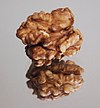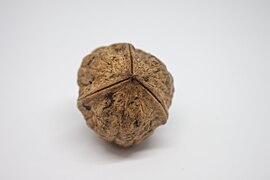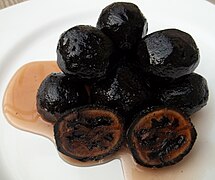Walnut





A walnut is the edible seed of a drupe of any tree of the genus Juglans (family Juglandaceae), particularly the Persian or English walnut, Juglans regia.
Although culinarily considered a "nut" and used as such, it is not a true botanical nut. After full ripening, the shell is discarded and the kernel is eaten. Nuts of the eastern black walnut (Juglans nigra) and butternuts (Juglans cinerea) are less commonly consumed.
Characteristics
Walnuts are rounded, single-seeded stone fruits of the walnut tree commonly used for food after fully ripening between September and November, in which the removal of the husk at this stage reveals a browning wrinkly walnut shell,[1] which is usually commercially found in two segments (three or four-segment shells can also form). During the ripening process, the husk will become brittle and the shell hard. The shell encloses the kernel or meat, which is usually made up of two halves separated by a membranous partition.[1] The seed kernels – commonly available as shelled walnuts – are enclosed in a brown seed coat which contains antioxidants. The antioxidants protect the oil-rich seed from atmospheric oxygen, thereby preventing rancidity.[2]
Walnut trees are late to grow leaves, typically not leafing out until more than halfway through the spring. They emit chemicals into the soil to prevent competing vegetation from growing. Because of this, susceptible plants should not be planted close to them.[citation needed]
History and cultivation
During the Byzantine era, the walnut was also known by the name "royal nut".[3] An article on walnut tree cultivation in Spain is included in Ibn al-'Awwam's 12th-century Book on Agriculture.[4] The walnut was originally known as the Welsh nut, i.e. it came through France and/or Italy to Germanic speakers (German Walnuss, Dutch okkernoot or walnoot, Danish valnød, Swedish valnöt). In Polish orzechy włoskie translates to "Italian nuts" (włoskie being the adjectival form of włochy ("Italy")).[5]
Types
why i look like carti[citation needed]
Production
| Country | Production (millions of tonnes) |
|---|---|
| 1.10 | |
| 0.71 | |
| 0.36 | |
| 0.29 | |
| 0.16 | |
| World | 3.32 |
| Source: FAOSTAT of the United Nations[6] | |
walnuts are im lil tay k i dont think you want no action u want action you get turned into pathmes yo boy stick well lets get to subtractin
Food use

Walnut meats are available in two forms: in their shells or de-shelled. The meats may be whole, halved, or in smaller portions due to processing. All walnuts can be eaten on their own (raw, toasted or pickled), or as part of a mix such as muesli, or as an ingredient of a dish: e.g. walnut soup, walnut pie, walnut coffee cake, banana cake, brownie, fudge. Walnuts are often candied or pickled. Pickled walnuts that are the whole fruit can be savory or sweet depending on the preserving solution.
Walnuts may be used as an ingredient in other foodstuffs. Walnut is an important ingredient in baklava, Circassian chicken, chicken in walnut sauce, and poultry or meat ball stew from Iranian cuisine.
Walnuts are also popular as an ice cream topping, and walnut pieces are used as a garnish on some foods.[7]
Nocino is a liqueur made from unripe green walnuts steeped in alcohol with syrup added.
Walnut oil is available commercially and is chiefly used as a food ingredient particularly in salad dressings. It has a low smoke point, which limits its use for frying.[8][9]
Nutritional value
 Walnut kernel, halves | |||||||||||||||||||||||||||||||||||||||||||||||||||||
| Nutritional value per 100 grams | |||||||||||||||||||||||||||||||||||||||||||||||||||||
|---|---|---|---|---|---|---|---|---|---|---|---|---|---|---|---|---|---|---|---|---|---|---|---|---|---|---|---|---|---|---|---|---|---|---|---|---|---|---|---|---|---|---|---|---|---|---|---|---|---|---|---|---|---|
| Energy | 2,738 kJ (654 kcal) | ||||||||||||||||||||||||||||||||||||||||||||||||||||
13.71 g | |||||||||||||||||||||||||||||||||||||||||||||||||||||
| Starch | 0.06 g | ||||||||||||||||||||||||||||||||||||||||||||||||||||
| Sugars | 2.61 g | ||||||||||||||||||||||||||||||||||||||||||||||||||||
| Dietary fiber | 6.7 g | ||||||||||||||||||||||||||||||||||||||||||||||||||||
65.21 g | |||||||||||||||||||||||||||||||||||||||||||||||||||||
| Saturated | 6.126 g | ||||||||||||||||||||||||||||||||||||||||||||||||||||
| Monounsaturated | 8.933 g | ||||||||||||||||||||||||||||||||||||||||||||||||||||
| Polyunsaturated | 47.174 g 9 g 38 g | ||||||||||||||||||||||||||||||||||||||||||||||||||||
15.23 g | |||||||||||||||||||||||||||||||||||||||||||||||||||||
| |||||||||||||||||||||||||||||||||||||||||||||||||||||
| Other constituents | Quantity | ||||||||||||||||||||||||||||||||||||||||||||||||||||
| Water | 4.07 g | ||||||||||||||||||||||||||||||||||||||||||||||||||||
| †Percentages estimated using US recommendations for adults,[10] except for potassium, which is estimated based on expert recommendation from the National Academies.[11] | |||||||||||||||||||||||||||||||||||||||||||||||||||||
Walnuts without shells are 4% water, 15% protein, 65% fat, and 14% carbohydrates, including 7% dietary fiber (table). In a 100-gram reference serving, walnuts provide 2,740 kilojoules (654 kcal) and rich content (20% or more of the Daily Value or DV) of several dietary minerals, particularly manganese at 163% DV, and B vitamins (table).
While English walnuts are the most commonly consumed, their nutrient density and profile are generally similar to those of black walnuts.[12][13]
Unlike most nuts, which are high in monounsaturated fatty acids, walnut oil is composed largely of polyunsaturated fatty acids (72% of total fats), particularly alpha-linolenic acid (14%) and linoleic acid (58%), although it does contain oleic acid as 13% of total fats.[12]
Health claims
In 2016, the US Food and Drug Administration (FDA) provided a Qualified Health Claim allowing products containing walnuts to state: "Supportive but not conclusive research shows that eating 1.5 ounces (43 g) per day of walnuts, as part of a low saturated fat and low cholesterol diet and not resulting in increased caloric intake, may reduce the risk of coronary heart disease."[14] The FDA had, in 2004, refused to authorize the claim that "Diets including walnuts can reduce the risk of heart disease"[15] and had sent an FDA Warning Letter to Diamond Foods in 2010 stating there is "not sufficient evidence to identify a biologically active substance in walnuts that reduces the risk of coronary heart disease."[16] A recent systematic review assessing the effect of walnut supplementation on blood pressure (BP) found insufficient evidence to support walnut consumption as a BP-lowering strategy.[17]
As of 2021, the relationship between walnuts and cognitive health is inconclusive.[18]
Non-food applications
Juice from boiled walnuts can be used as an antifungal agent. Green husks can be crushed and sprinkled into water to poison fish.[19]
Folk medicine
Walnuts have been listed as one of the 38 substances used to prepare Bach flower remedies,[20] a herbal remedy promoted in folk medicine practices for its supposed effect on health. According to Cancer Research UK, "there is no scientific evidence to prove that flower remedies can control, cure or prevent any type of disease, including cancer".[21]
Inks and dyes
Walnut husks can be used to make a durable ink for writing and drawing. It is thought to have been used by artists including Leonardo da Vinci and Rembrandt.[22]
Walnut husk pigments are used as a brown dye for fabric[23] and were used in classical Rome and medieval Europe for dyeing hair.[24]
Woodworking
The fine, straight-grained wood of the black walnut is highly valued as furniture wood, wall paneling, automobile interiors, and for gunstocks.[25]
Cleaning
The United States Army once used ground walnut shells for abrasive blasting to clean aviation parts because of low cost and low abrasive qualities. However, an investigation of a fatal Boeing CH-47 Chinook helicopter crash (September 11, 1982, in Mannheim, Germany) revealed that walnut shell grit had clogged an oil port, leading to the accident and the discontinuation of walnut shells as a cleaning agent.[26] Commercially, crushed walnut shells are still used outside of aviation for low-abrasive, less-toxic cleaning and blasting applications.[27]
Phytochemicals
Walnut hulls contain diverse phytochemicals, such as polyphenols that stain hands and can cause skin irritation. Seven phenolic compounds, including ferulic acid, vanillic acid, coumaric acid, syringic acid, myricetin, and juglone were identified in walnut husks. Juglone, the predominant phenolic, was found in concentrations of 2-4% fresh weight.[28]
Walnuts also contain the ellagitannin pedunculagin.[29] Regiolone has been isolated with juglone, betulinic acid and sitosterol from the stem bark of J. regia.[30]
Chinese culture
Large, symmetrically shaped, and sometimes intricately carved walnut shells (mainly from J. hopeiensis ) are valued collectibles in China where they are rotated in the hand as a plaything or as decoration. They are also an investment and status symbol, with some carvings having high monetary value if unique.[31] Pairs of walnuts are sometimes sold in their green husks for a form of gambling known as du qing pi.[1]
Cultivars
- Ashley
- Chandler[32]
- Cisco[32]
- Dawson[32]
- Eureka[32]
- Feradam
- Ferbel
- Ferjean
- Fernette[32]
- Fernor
- Ferouette
- Forde[32]
- Franquette[32]
- Grandjean[33]
- Germisara
- Gillet[32]
- Hansen
- Hartley[32]
- Howard[32]
- Hu
- Ivanhoe[34]
- Jupanesti
- Lara
- Livermore
- Marbot
- Mayette[35]
- Meylanaise[35]
- Paradox
- Parisienne
- Payne[32]
- Poe [32]
- Robert Livermore [32]
- Rita
- Ronde de Montignac
- Royal
- Serr[32]
- Sexton[32]
- Solano[32]
- Sunland[32]
- Tehama[32]
- Tulare[32]
- Valcor
- Vina[32]
- Wilson's Wonder
- Yolo
Gallery
-
Common walnut in growth
-
California black walnut in growth
-
A three-segment shell which occurs rarely
-
Walnut in shell and a nutcracker utensil used to break the shell
-
Video of cracking a walnut
-
Walnut meats
-
Broken walnut meats
-
Applesauce coffee cake garnished with walnuts
-
Walnuts as collectibles
-
Muraba made from young walnuts
See also
References
- ^ a b Grant, Amy (19 April 2021). "Walnut Tree Harvesting: When Are Walnuts Ready To Pick". Gardening Know How. Retrieved 4 December 2021.
{{cite web}}: CS1 maint: url-status (link) - ^ Cite error: The named reference
wde1was invoked but never defined (see the help page). - ^ Geoponika - Agricultural Pursuits. Vol. 2. Translated by Owen, T. London: University of Oxford. 1806., pp. 49–50 (note 1)
- ^ Ibn al-'Awwam, Yaḥyá (1864). Le livre de l'agriculture d'Ibn-al-Awam (kitab-al-felahah) (in French). Translated by J.-J. Clement-Mullet. Paris: A. Franck. pp. 271–276 (ch. 7 - Article 24). OCLC 780050566. (pp. 271–276 (Article XXIV)
- ^ "Online Etymology Dictionary". Etymonline.com. Retrieved 7 January 2015.
- ^ "Walnut (in shell) production in 2020, Crops/Regions/World list/Production Quantity (pick lists)". UN Food and Agriculture Organization, Corporate Statistical Database (FAOSTAT). 2020. Retrieved 17 May 2022.
- ^ Forsberg, B.; Joan Clark-Warner, M.S.R.D.C.D.E.; Beale, L. (2004). The Complete Idiot's Guide to Terrific Diabetic Meals. DK Publishing. p. 98. ISBN 978-1-61564-486-5. Archived from the original on March 31, 2018. Retrieved May 27, 2017.
- ^ "Walnut oil recipes". BBC. Archived from the original on 17 February 2014. Retrieved 3 July 2014.
- ^ Turner, Lisa. "Oil Change". Better Nutrition. Archived from the original on 6 July 2014. Retrieved 5 July 2014.
- ^ United States Food and Drug Administration (2024). "Daily Value on the Nutrition and Supplement Facts Labels". FDA. Archived from the original on 2024-03-27. Retrieved 2024-03-28.
- ^ National Academies of Sciences, Engineering, and Medicine; Health and Medicine Division; Food and Nutrition Board; Committee to Review the Dietary Reference Intakes for Sodium and Potassium (2019). Oria, Maria; Harrison, Meghan; Stallings, Virginia A. (eds.). Dietary Reference Intakes for Sodium and Potassium. The National Academies Collection: Reports funded by National Institutes of Health. Washington, DC: National Academies Press (US). ISBN 978-0-309-48834-1. PMID 30844154. Archived from the original on 2024-05-09. Retrieved 2024-06-21.
- ^ a b "Nutrition facts: Nuts, walnuts, English dried per 100 g". Condé Nast. Archived from the original on 5 July 2014. Retrieved 4 July 2014.
- ^ "Nutrition facts: Nuts, walnuts, black, dried per 100 g". Condé Nast. Archived from the original on 5 July 2014. Retrieved 4 July 2014.
- ^ "Qualified Claims About Cardiovascular Disease Risk: Walnuts & Heart Disease Docket No. 02P-0292". US Food and Drug Administration. 9 March 2004. Archived from the original on 27 October 2016. Retrieved 1 November 2016.
- ^ Laura M. Tarantino (9 March 2004). "Qualified Health Claims: Letter of Enforcement Discretion – Walnuts and Coronary Heart Disease (Docket No 02P-0292)". US Food and Drug Administration, Labeling and Nutrition. Archived from the original on 7 May 2017. Retrieved 30 April 2017.
- ^ Wagner, Roberta (22 February 2010). "FDA Warning Letter to Diamond Food, Inc". US Food and Drug Administration, Inspections, Compliance, Enforcement, and Criminal Investigations. Archived from the original on 12 January 2017. Retrieved 1 November 2016.
the evidence supporting a relationship between walnuts and coronary heart disease is related to the omega-3 fatty acid content of walnuts. There is not sufficient evidence to identify a biologically active substance in walnuts that reduces the risk of coronary heart disease. Therefore, the above statement is an unauthorized health claim
{{cite web}}: CS1 maint: bot: original URL status unknown (link) - ^ Li J, Jiang B, O Santos H, Santos D, Singh A, Wang L. Effects of walnut intake on blood pressure: A systematic review and meta-analysis of randomized controlled trials. Phytother Res. 2020. doi: 10.1002/ptr.6740. Epub ahead of print. PMID: 32510725.
- ^ Cahoon, Danielle; Shertukde, Shruti, P; Avendano, Esther E; Tanprasertsuk, Jiraya; Scott, Tammy M; Johnson, Elizabeth J; Chung, Mei; Nirmala, Nanguneri (2021). "Walnut intake, cognitive outcomes and risk factors: a systematic review and meta-analysis". Annals of Medicine. 53 (1): 972–998. doi:10.1080/07853890.2021.1933165. PMC 8189130. PMID 34096808.
{{cite journal}}: CS1 maint: multiple names: authors list (link) - ^ The Complete Guide to Edible Wild Plants. United States Department of the Army. New York: Skyhorse Publishing. 2009. p. 107. ISBN 978-1-60239-692-0. OCLC 277203364.
{{cite book}}: CS1 maint: others (link) - ^ D. S. Vohra (1 June 2004). Bach Flower Remedies: A Comprehensive Study. B. Jain Publishers. p. 3. ISBN 978-81-7021-271-3. Archived from the original on 31 December 2013. Retrieved 2 September 2013.
- ^ "Flower remedies". Cancer Research UK. 26 January 2015. Archived from the original on 11 September 2013. Retrieved 1 September 2013.
- ^ "Black Walnut Ink Workshop". Guild of Natural Science Illustrators. October 2002. Archived from the original on 9 October 2014. Retrieved 3 July 2014.
- ^ "The Colors of Invention – How to Dye Fibers Naturally". Smithsonian Museum. November 13–16, 1997. Archived from the original on 21 October 2014. Retrieved 3 July 2014.
- ^ Sherrow, Victoria (2006). Encyclopedia of Hair: A Cultural History. Greenwood Publishing Group. pp. 267, 355. ISBN 978-0-313-33145-9. Retrieved 3 July 2014.
walnut.
- ^ Robert D. Williams (1980). "Black walnut". US Department of Agriculture. Retrieved 29 August 2021.
- ^ "In Re Air Crash Disaster at Mannheim Germany on 9/11/82. Ursula J. Schoenborn, As Executrix of the Estate of Leonedward Schoenborn, Deceased, v. the Boeing Company. Appeal of the Boeing Company. United States Court of Appeals, Third Circuit. 769 F.2d 115". Justia. 1985. Archived from the original on 17 May 2014. Retrieved 10 April 2014.
- ^ "OSHA fact sheet addresses abrasive blasting hazards". Retrieved 2018-08-20.
- ^ Cosmulescu, Sina Niculina; Trandafir, Ion; Achim, Gheorghe; Botu, Mihai; Baciu, Adrian; Gruia, Marius (15 June 2010). "Phenolics of Green Husk in Mature Walnut Fruits". Notulae Botanicae Horti Agrobotanici Cluj-Napoca. 38 (1): 53–56. doi:10.15835/nbha3814624 (inactive 31 July 2022). ISSN 1842-4309. Archived from the original on 29 July 2017. Retrieved 11 October 2016.
{{cite journal}}: CS1 maint: DOI inactive as of July 2022 (link) - ^ Metabolism of Antioxidant and Chemopreventive Ellagitannins from Strawberries, Raspberries, Walnuts, and Oak-Aged Wine in Humans: Identification of Biomarkers and Individual Variability. Begoña Cerdá, Francisco A. Tomás-Barberán, and Juan Carlos Espín, J. Agric. Food Chem., 2005, 53 (2), pages 227–235, doi:10.1021/jf049144d
- ^ (−)-Regiolone, an α-tetralone from Juglans regia: structure, stereochemistry and conformation. Sunil K. Talapatra, Bimala Karmacharya, Shambhu C. De and Bani Talapatra, Phytochemistry, Volume 27, Issue 12, 1988, pages 3929–3932, doi:10.1016/0031-9422(88)83047-4
- ^ "Status-conscious investors shell out on great walnuts of China". Reuters. Aug 28, 2012. Archived from the original on 2015-11-14.
{{cite web}}: Unknown parameter|authors=ignored (help) - ^ a b c d e f g h i j k l m n o p q r s t "Walnut Cultivar Table". Fruit and Nut Information Center, Department of Plant Sciences, University of California, Davis. 2018. Archived from the original on 8 February 2018. Retrieved 6 March 2018.
- ^ Le Verger Francais tomme II Chapitre I Fruits Locaux & Regionaux 1948
- ^ "Walnut tree named 'Ivanhoe'; Patent number USPP21718P2". US Patent and Trade Office (Google Patents). 8 December 2009. Archived from the original on 2 February 2017.
{{cite web}}: Unknown parameter|authors=ignored (help) - ^ a b Le Verger Francais, Tome 1 Catalogue Descriptif des Fruits Adoptes 1947
Further reading
- Ramos, David D. (1997). Walnut Production Manual. UCANR. ISBN 978-1-879906-27-3.
- Smith, Jane S. (2009). The Garden of Invention Luther Burbank and the Business of Breeding Plants. Penguin Books. ISBN 978-0-14-311689-9.
External links
- "Walnut" at the Encyclopedia of Life











